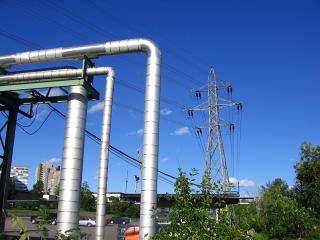One characteristic of electricity poses severe challenges both for the drive towards lower carbon emissions and towards more power based on renewables: the fact that supply must precisely match demand at all times. On account of this, power plants are divided into two categories – base plants, which constantly provide the amount of power normally demanded by homes and businesses, and peaker plants, which provide some extra juice when everyone decides to turn on the air conditioning at once.
The first reason this is a problem is that peaker plants are much less efficient. It is costly to build an efficient oil or gas plant, and it just isn’t worth it to do so for one that runs relatively rarely. The second problem is more to do with the inconsistent nature of renewable power; the wind does not always blow and the sun does not always shine. As such, we need enough on-demand energy (usually based on fossil fuels) to fill the gap between what windmills can produce at time X and what consumers demand then. Plants on standby may not use much fossil fuel, but maintaining and operating them uses resources in a way that makes renewable options less appealing than otherwise.
The answer is obviously energy storage. We can build dams with two reservoirs, one uphill from the other. When power is in excess, we can pump water from the low reservoir to the high one. It can then be passed through turbines at times of peak demand to recover energy. Apparently, this can be done with efficiency of about 85%. Other options along these lines would be to have clusters of offshore wind turbines that use electrolysis to make hydrogen from seawater. That can be piped or carried to shore and used to produce carbon-free energy.
To me, it seems like another option is to use technology and incentives to help moderate power demand. If there are industries that can use a lot of power or a little, switching easily, then should be encouraged to become part of the swing capacity. It may even be worthwhile to store energy as heat in sinks or as kinetic energy in flywheels. If houses could heat or cool a block of material at the time when power is cheapest, then use that potential for heating or cooling across the day, we might need less peak capacity.
Some kind of competition for inventing fossil-fuel-free peak-power solutions may well be in order. If the technology exists, and there is enough of a cost differential between times of highest and lowest demand, it may well transpire that infrastructure can be built to normalize power demand on the scale of days, or even weeks.


I reckon that solar power is the solution. Most peak energy periods as you said are going to come during the summer when air conditioners are sucking back all the electricity. Obviously it is not cost efficient now but if there are the rights incentives to invest for both government and private interests then Im sure soon enough it could be.
Another man’s poisson
Aug 6th 2007
From Economist.com
The argument for giving up fish
See also:
KombiKraftwerk
Going with the flow
Giant batteries: The missing piece of the renewable-power jigsaw may now have been found in the form of a new type of flow battery